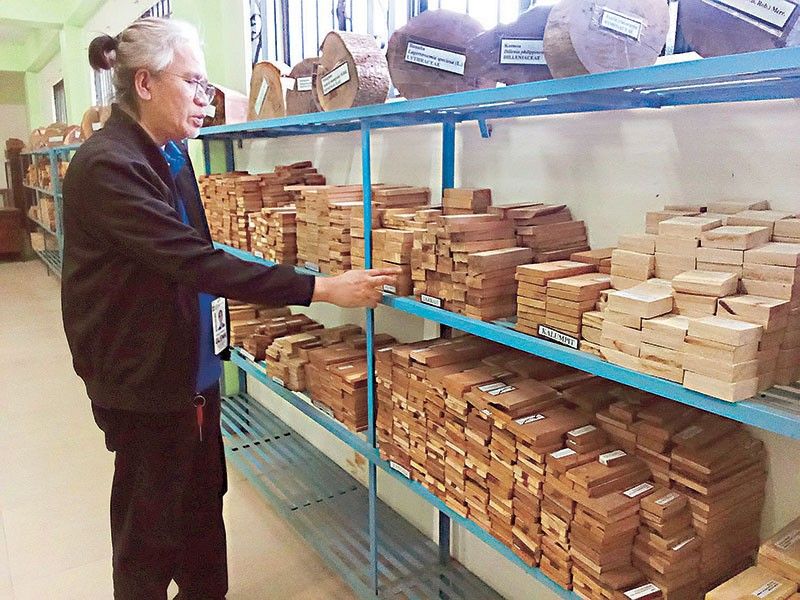Xylarium: A national treasure on Makiling’s foothills

Los Baños, Philippines — On the foothills of Mt. Makiling sits a national treasure – a wood collection representing more than 90 percent of Philippine tree species – an important reference for archaeologists, foresters, researchers and students.
Housed in the Forest Product Research and Development Institute (FPRDI) at the forestry complex of the University of the Philippines-Los Baños, the Herbarium/Xylarium contains 2,631 herbarium specimens (810 species from 339 genera and 110 families) and the most complete wood collection of 10,983 authentic specimens in the country (2,282 species under 463 genera and 197 families of tree species).
“This is a very rare and valuable collection since some of the collected species no longer exist in natural forests,” says forester Glenn Estudillo, the Xylarium’s curator, pointing to the katagpo tree (Psychotria ilocana) which has been extinct in the wild for more than 100 years. “We have to protect this collection.”
A xylarium is a collection of authenticated wood specimens, from the Greek xylon for “wood” and Latin arium meaning “separate place” (similar to terrarium and aquarium). The Xylarium has a sister facility, the Herbarium, currently a collection of 2,631 preserved plant specimens.
The FPRDI, under the Department of Science and Technology, is the country’s only certifying body in wood identification, its collections the basis for wood identification in the Philippines.
The Xylarium is about to go digital. Estudillo and his only assistant, forester Aeron Casey Estudillo, are digitizing images and information about the wood samples to better preserve the data about the wood collection. Information and photos are uploaded and a QR code is assigned to each specimen for indexing and quick access to data.
“We can utilize advanced technology to cross-reference DNA profiles of challenging anatomical wood samples with a comprehensive database,” says FPRDI director Rico Cabangon. This will accurately identify the species and the origin of timber, bamboo and other forest products, he says.
Wood identification is the scientific process of establishing the identity of a wood specimen based on its anatomical, physical and structural properties – and with cutting-edge molecular-level research and development.
Major George Ahern of the US Army, the first head of the Bureau of Forestry, started the wood collection in 1903. At that time, the country’s forest cover was over 90 percent of the land area; it has since dwindled from 28 million hectares to less than six million hectares today.
Ahern and dedicated botanists – including Americans Frederick Foxworthy, Hugh Curran, E.D. Merrill, A.D.E. Elmer and Filipinos F. Tamesis and F. Salvosa – collected specimens nationwide.
“Almost 2,200 species consisting of 10,983 wood samples were collected, representing 98 percent of tree species in the Philippines,” Estudillo says. “It is a national treasure due to the extensiveness and completeness of the collection that cannot be replicated due to logistics and financial constraints today.”
The oldest sample is “1 BF” Gisok (Shorea falciferoides) collected by W.H. Wade from Lagusmanoc, Tayabas (now Quezon province) in September 1903. Classified as “critically endangered” by the International Union for Conservation of Nature, gisok trees are extremely rare, found mostly in the Sierra Madre mountain range.
The last specimen collected for the Xylarium was made in 1955, Estudillo says, noting it would be difficult to restart collecting specimens because of funding constraints.
The Xylarium is a go-to place, not just in the name of science. “The police, the National Bureau of Investigation and environment officials consult us to identify the legal status of confiscated wood and confirm if it is protected and endangered,” Estudillo says. “Sometimes, we are asked to go with raiding teams then testify in court.”
The Xylarium’s wood identification test also verifies the authenticity and quality of wood materials used in the construction, furniture and handicraft industries. Testing fee, as of June 2024, starts at P450.
“We’re the only one in the country to certify wood identity,” Estudillo says.
In 2022, the FPRDI received a request from a foreign film company to identify wood samples from a shipwreck. The ship was believed to be part of the Manila-Acapulco Galleon Trade.
The specimens were first sent to laboratories in the United States, but their identities could not be established. The request was referred to the Xylarium and, with FPRDI wood scientists, it identified the specimens as molave (Vitex parviflora) and supa (Sindora supa), trees endemic to the Philippines and widely used in the construction of galleons.
- Latest
- Trending





























